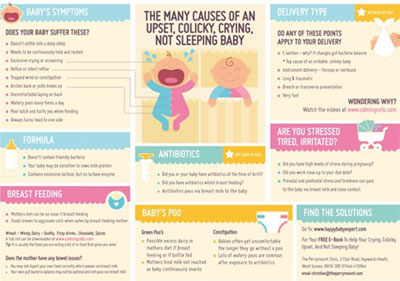Colic Reflux Wind Are Symptoms. Find the CAUSE
Video Transcript:
Lots of mums come in and one of the first things they say is: “I think my baby has colic” or they ask me if I can help them decide whether their baby’s got colic or wind or reflux. They want to know the symptom that the baby has, and this is what this video is about.
They’re just symptoms, so it almost doesn’t matter which one they’ve got because what we want to know is the cause, not the symptom. The symptom helps us know what’s wrong with them.
They’re crying a lot, they’re screaming, what sort of scream they’ve got, is it high-pitched, is the scream or the crying going in waves, is it continuous through the day, or do they sleep well and then it comes back, is it night day witching hour? That’s all really helpful, but they’re symptoms, and this whole course is about the cause.
When you find the cause then you can fix that. That’s what’s important to you, because whether they’re windy, screaming, crying, you want the whole lot better anyway, and that’s what we’re after. So, mums come in and they ask and I have to explain to them that we’re going to find the cause.
Now, reflux is obviously a bit different. It’s good to know if the baby’s got colic or reflux because they are pretty different, but then there is the confusion over silent reflux like: “… Oh, your baby’s got reflux but we can’t see it…” So, you know, it’s a slightly harder one to understand, but I want to get across to you that they’re symptoms.
Find the cause. So, I like to say, if we talk about colic, for example, and the mum’s had antibiotics, we say your baby has colic due to antibiotics, or if you had a c-section your baby has
colic due to a c-section, or your baby is really stiff and arching because they had a forceps delivery, and then let’s calm them down for the forceps delivery, or your baby’s scrunched up in a little frog baby birth-type, and they’re like that because you had a planned c-section, and those
babies are jumpy and they don’t like laying on their back, and they’ve got to go on their side, and you’ve got to hold them all the time.
So, we find out the “why” and then we apply the help to the “why”. So, if they had antibiotics – so, “…my baby has colic due to antibiotics….” so we use the probiotics to help them. “… my baby had a planned c-section and they are really, really ratty…” so we’ll apply treatment, techniques that unwinds them to calm them down so they can lay on their back and they’re less jumpy.
So, this is what I want to get across to you on this video – colic, reflux, wind, crying, screaming, the descriptions of your baby and their symptoms – but this course is about finding the cause and then fixing that, and as I’ve said loads of times, not only…. here’s the colic here’s the reason, here’s the fix. You’re helping them in the future, as well. Setting this all up now is helping them and setting them up for good bacteria and improved health in the future, too. So it’s a great thing to look at right now.





No Comments